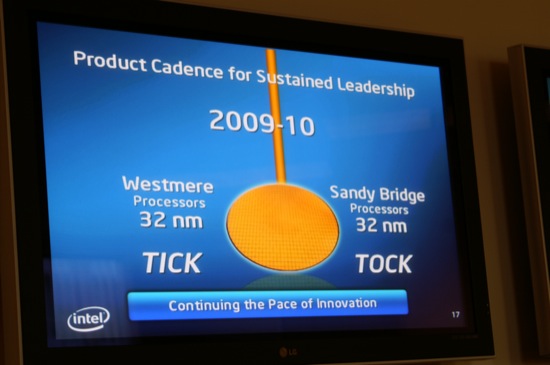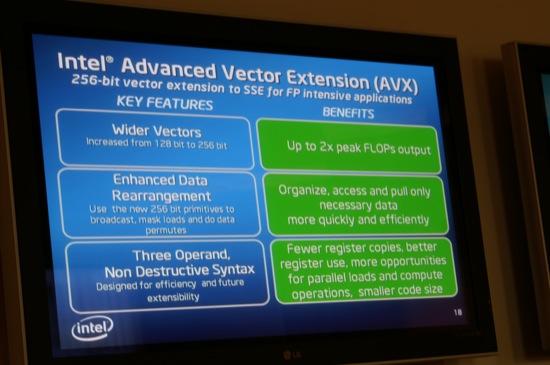Nehalem Part 3: The Cache Debate, LGA-1156 and the 32nm Future
by Anand Lal Shimpi on November 19, 2008 8:00 PM EST- Posted in
- CPUs
What’s Next: A Preview of Westmere and Sandy Bridge
Conroe was designed to address a deficiency in the desktop and mobile markets and Nehalem to tidy up the workstation/server space, so what’s next? Westmere and Sandy Bridge are the 32nm followons and Intel has already hinted at the major changes coming in that generation: power consumption and floating point performance.
Westmere will be little more than a die shrink to 32nm, we may get some more cache but I wouldn’t expect significant performance improvements other than from clock speeds. Westmere will take Nehalem’s power efficiency and combine it with a pure power reduction to be quite a threat.
Sandy Bridge will add support for AVX:
By the end of 2009 we should have support for both OpenCL and DirectX 11 by GPUs from all vendors, including Intel with Larrabee. These APIs in combination with the highly parallel nature of the GPUs that will be able to run them, should allow for some incredible speedups on highly data parallel applications. While most of these applications are currently limited to the scientific field, we’ll start to see them appear in the consumer space (we’re starting to already with video transcoding and Photoshop).
Not all applications are data parallel enough to run well on a GPU, but they may require more than what present day CPUs can offer in terms of floating point throughput. Intel’s AVX instructions are designed to bridge the gap between the CPU and the GPU, offering an alternative to developers who could stand the gain performance from running some of their code on a GPU but would rather keep the work on the CPU itself to make programming simpler. Developers will move their code off to the GPU if the performance is worthwhile, but if you can get similar performance gains without recoding, that’s the preferred avenue. Make sense?
Eventually I’m guessing we’ll see the Larrabee and Nehalem lines of the x86 ISA merge, AVX is merely the first step in that direction.
Final Words
Another day, another chapter on Nehalem comes to an end. I’m back from 10 days in Texas and California, visiting the usual suspects and there’s much more to write about. We’re finally getting wind of X58 motherboards at well below $300, have much more to talk about with overclocking and there’s still that issue of multi-tasking performance.
Nehalem may have launched, but our work is far from done this year. Stay tuned.












33 Comments
View All Comments
whatthehey - Thursday, November 20, 2008 - link
Okay, my first sentence or two was off base, I admit. It's because piesquared made an assinine comment about an article. Anand gives an interesting piece about cache sizes, and some prick responds with, "nope - all I care about is hearing about AMD's same-old same-old designs!" Most of us like to think about the ramifications of cache sizes and CPU architectures, and frankly AMD doesn't have a lot to discuss in that area right now. Nehalem is a pretty major change to Intel's recent architectures, and as such it's worth discussing.If you'd climb off your high horse for a minute and read the rest of my post (rather than getting your "I Love AMD" dander up, oh great and noble Griswold, defender of AMD), you'd see a lot of facts that are hard to argue with. Performance wise, AMD is sucking Intel's dust in pretty much every area except 8S heavily loaded servers, and there the bigger deal is they do better in performance per watt. Pricing on their CPUs is good, but only because they need to lower prices in order to compete - and Intel has been matching them quite well.
That said, anyone that doesn't see MASSIVE problems for AMD right now has some serious blinders on. This new Foundry Company split is going to put a stake in their heart, mark my words. I only hope someone steps in to fill the void when AMD inevitably fails and disappears, because you just can't compete with Intel by breaking your business into smaller pieces that will have more problems working together than they do when they're all under the same umbrella. If AMD is already behind schedules repeatedly with the current setup, how are they going to do better when they become fabless and have to go through a third party for the various stages of production?
Regs - Thursday, November 20, 2008 - link
AMD's primary problem in the industry is setting a tangible goal/dead line and actually meeting that goal or dead line. "Well at least they won't release it all buggy en' what not". Maybe that line works for video games, but not in this cut throat industry. Intel has been beating AMD to the punch time and again in the CPU market and eroding AMD's sales and market share. Which is why AMD has to retool, reorganize, and follow through with their roadmaps or else they'll have to figure out what products they can actually compete with. Shanghai, even though a little 18 months late, is a good sign of execution by AMD; delaying a CPU/GPU combination platform for a notebook until 2011 is not. Notebooks are a big source a revenue AMD will be passing up in the next 2 years to Intel and they're really going to need something highly competitive if they wish to earn any market share back by 2011.Lonyo - Wednesday, November 19, 2008 - link
If the Lynnfield has x16 PCIe, and the diagram shows no SB/MCH, does that mean the P55 will be a single chip design and include the extra PCIe slots, and might it be possible to do triple SLI if manufacturers use the PCIe slots from the CPU as well as the chipset?